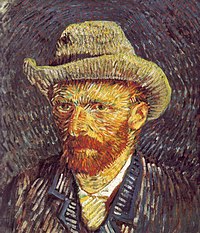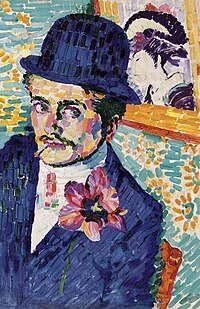Divisionism
| A Sunday Afternoon on the Island of La Grande Jatte | |
|---|---|
 |
|
| Artist | Georges Seurat |
| Year | 1884–86 |
| Medium | Oil on canvas |
| Dimensions | 207.6 cm × 308 cm (81.7 in × 121.3 in) |
| Location | Art Institute of Chicago, Chicago |
| Portrait of Félix Fénéon | |
|---|---|
 |
|
| Artist | Paul Signac |
| Year | 1890 |
| Medium | Oil on canvas |
| Dimensions | 73.5 cm × 92.5 cm (28.9 in × 36.4 in) |
| Location | The Museum of Modern Art, New York |
| Self-Portrait with Felt Hat | |
|---|---|
 |
|
| Artist | Vincent van Gogh |
| Year | 1888 |
| Medium | Oil on canvas |
| Dimensions | 44 cm × 37.5 cm (17.3 in × 14.8 in) |
| Location | Van Gogh Museum, Amsterdam |
| La danse, Bacchante | |
|---|---|
 |
|
| Artist | Jean Metzinger |
| Year | 1906 |
| Medium | Oil on canvas |
| Dimensions | 73 cm × 54 cm (28.7 in × 21.2 in) |
| Location | Rijksmuseum Kröller-Müller, Otterlo, Netherlands |
| L'homme à la tulipe (Portrait de Jean Metzinger) | |
|---|---|
 |
|
| Artist | Robert Delaunay |
| Year | 1906 |
| Medium | Oil on canvas |
| Dimensions | 72.4 cm × 48.5 cm (28.5 in × 19.1 in) |
Divisionism (also called chromoluminarism) was the characteristic style in Neo-Impressionist painting defined by the separation of colors into individual dots or patches which interacted optically.
By requiring the viewer to combine the colors optically instead of physically mixing pigments, Divisionists believed they were achieving the maximum luminosity scientifically possible. Georges Seurat founded the style around 1884 as chromoluminarism, drawing from his understanding of the scientific theories of Michel Eugène Chevreul, Ogden Rood and Charles Blanc, among others. Divisionism developed along with another style, Pointillism, which is defined specifically by the use of dots of paint and does not necessarily focus on the separation of colors.
Divisionism developed in nineteenth-century painting as artists discovered scientific theories of vision that encouraged a departure from the tenets of Impressionism, which at that point had been well-developed. The scientific theories and rules of color contrast that would guide composition for Divisionists placed the movement of Neo-Impressionism in contrast with Impressionism, which is characterized by the use of instinct and intuition. Scientists or artists whose theories of light or color had some impact on the development of Divisionism include Charles Henry, Charles Blanc, David Pierre Giottino Humbert de Superville, David Sutter, Michel Eugène Chevreul, Ogden Rood and Hermann von Helmholtz.
Divisionism, along with the Neo-Impressionism movement as a whole, found its beginnings in Georges Seurat's masterpiece, A Sunday Afternoon on the Island of La Grande Jatte. Seurat had received classical training at the École des Beaux-Arts, and, as such, his initial works reflected the Barbizon style. In 1883, Seurat and some of his colleagues began exploring ways to express as much light as possible on the canvas By 1884, with the exhibition of his first major work, Bathing at Asnières, as well as croquetons of the island of La Grande Jatte, his style began taking form with an awareness of Impressionism, but it was not until he finished La Grande Jatte in 1886 that he established his theory of chromoluminarism. In fact, La Grande Jatte was not initially painted in the Divisionist style, but he reworked the painting in the winter of 1885-6, enhancing its optical properties in accordance with his interpretation of scientific theories of color and light
...
Wikipedia
